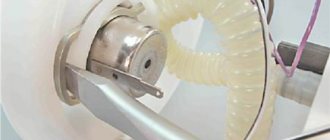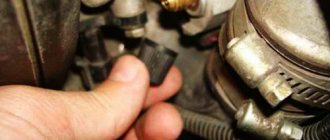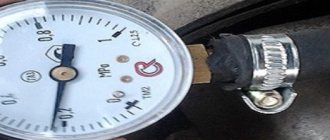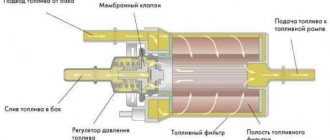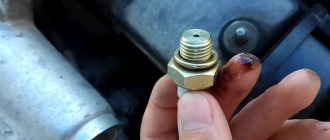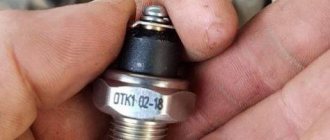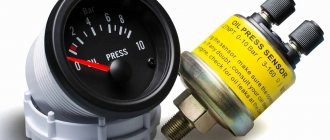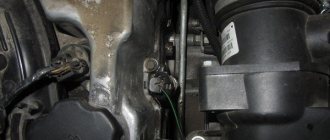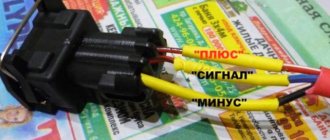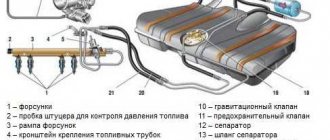How to change the pressure sensor on a car's fuel rail
The fuel rail sensor, like any part of the fuel system, can malfunction, usually resulting in a rough running engine, ignition problems, or other instances where the check engine light comes on.
The ATC fuel rail pressure sensor is a part that can reduce evaporative emissions by delivering a specific amount of fuel to the engine to keep it running properly. A pressure sensor ensures that excess fuel does not remain in the conductive channel.
The sensor's job is to determine the pressure directly in the fuel rail, thereby determining the exact amount of fuel in the rail. When the sensor detects the presence of fuel, an electrical signal is sent to the fuel pump for further pumping. As soon as the fuel pressure reaches a certain point, the fuel pump receives a signal to stop working. When the pressure decreases, a request is made to renew the fuel supply.
When a pressure sensor malfunctions, it can be determined by some initial signs that will tell you that something is wrong. Usually there are difficulties with ignition: it takes longer than expected to start the starter. In addition, the engine begins to operate unevenly. Sometimes problems with the pressure sensor on the fuel rail even lead to the engine simply stalling during normal operation.
The following are the alarm codes (for machines with a computer system) that correspond to the pressure sensor: P0087, P0088, P0170, P0171, P0172, P0173, P0174, P0175, P0213, P0214, P0190, P0191, P0192, P0193, P0194.
Installation locations
The installation location of this element depends on the design features of the power system. In most cases, cars use fuel recirculation systems. Its peculiarity comes down to the fact that excess fuel, which has already arrived at the injectors, is drained back into the tank. In such a system, the regulator is installed on the fuel rail (where the fuel is located before entering the injectors).
But there are also systems in which recirculation is not structurally provided for, although they are rare. Since there is no discharge of part of the gasoline from the ramp, the pressure in the system is adjusted before the fuel enters the ramp. In such systems, this element is installed immediately behind the fuel pump. It can be embedded in the fuel line or located in the tank.
Everything about repair, tuning, design, operation of a car, tips, auto news, auto facts
Repairing the fuel level sensor is an important process. Even if the operation of this unit does not directly affect driving safety, its incorrect data can cause accidents on the road.
Based on the information provided by the meter, you can plan trips or refuel your car. Therefore, it is not recommended to delay, but to repair or replace sensors on time. In order to prevent troubles on the road, you need to know what the system of this device is, how to check and adjust it. An example is the VAZ 2110 model.
How to repair a fuel level sensor
Design Features
The gasoline pressure regulator is one of the few elements of the system that is not controlled from an electronic unit. This unit is completely mechanical and its operation is based on pressure differences. Although in systems without recirculation, the sensor is triggered by the ECU. Since they do not occur often, we will not consider such nodes further.
It is worth noting that the RTD does not operate in strictly specified values, it adapts to the operating mode of the engine. That is, if necessary, it increases or decreases the pressure in the system to ensure optimal mixture formation.
Structurally, this element is very simple and consists of a housing on which fittings and leads are located for connection to the power system. Inside, this housing is divided by a membrane into two chambers - fuel and vacuum.
There are outlets suitable for the fuel cavity - one is used to supply fuel to the chamber, and the second leads to the line for draining gasoline into the tank (return). But the second channel is closed by a valve, which is connected to the membrane.
A spring is installed on the side of the vacuum cavity, which acts on the membrane, ensuring that the drain channel is closed by the valve. This chamber is connected to the intake manifold by means of a fitting via a tube.
Potentiometer and its problems
Modern cars are equipped with a wide variety of fuel level sensors. The widest niche has been occupied by sensors based on potentiometers. This type of conversion of fuel level information into an electrical signal has many advantages. There are two types of sensors based on this method of measuring fuel level:
- lever (widespread)
- tubular (used mainly on large vehicles)
If the lever-type fuel level sensor does not indicate the fuel level correctly, the reason associated with the potentiometer and causing this malfunction may be as follows:
- Potentiometer contacts have oxidized
- there has been natural wear on the tracks or slider of the resistor
- natural aging of the resistor
- resistor does not match the nominal value
Potentiometer Diagnosis and Troubleshooting
A symptom that the potentiometer contacts have oxidized is a temporary lack of accurate information about the fuel level in the gas tank. The owner notices that from time to time the indicator shows reliable information. Usually, in this case, the light indicating the end of fuel works flawlessly.
To diagnose this malfunction, it is necessary to visually inspect the variable resistor of the fuel level sensor. The oxides will appear different from the normal color. Based on their number, a decision is made on what to do next:
- clean (in case of a small amount of oxides)
- move the slider (if only part of the tracks are oxidized)
- replace the fuel level sensor with a new one (if the oxides are significant and have led to damage to the tracks or slider)
A symptom of natural wear of the tracks and runner is either a complete failure of the sensor, or its correct operation only in certain areas. A visual inspection in this case shows that the tracks are worn out, and in more rare cases, damage to the runner.
If it is possible to move (bend) the slider to an undamaged area, the sensor will please the owner with its long-term, proper operation. But if the runner is damaged, or the tracks are seriously damaged, repairs do not make sense. It is necessary to purchase a new fuel level sensor.
To establish the next reason why the fuel sensor does not work, you need a multimeter or an ohmmeter of any design. A resistor can change its resistance and, as a result, display unreliable information. Checking the resistance value with an empty, full and half-filled gas tank will help identify this problem. Repair in this case is not advisable, since it is safer to install a new sensor.
Location in the vehicle structure
In modern cars, two layouts of the fuel pressure regulator are used. In systems with a return line, it is installed on the fuel rail, and in designs without a “return” - directly inside the fuel tank (in the pump). The diagram located on the fuel rail involves connecting the regulator to two lines of the system:
Layout of the fuel pressure regulator in the system
- inlet - the supply channel from the fuel tank to the power system;
- return exhaust – channel for draining excess fuel (pressure relief).
In such a system, when the regulator opens, excess fuel enters the return line and then into the fuel tank. This scheme has some disadvantages:
- complexity of the design and the need to install an additional pipeline;
- heating of excess fuel when it enters the ramp, which increases the vapors generated in the tank.
Each fuel regulator has its own factory settings and is suitable for a given car model. There are also universal designs for injection systems, which are equipped with pressure gauges and the ability to manually adjust. They are installed instead of the standard regulator exclusively in the fuel rail.
When the fuel pressure regulator is placed directly in the tank, the required amount of working fluid with a given compression level immediately enters the engine without the use of an additional line. In this case, the excess is also discharged directly into the tank, but it does not enter the engine compartment, which eliminates its heating.
In this case, a constant pressure difference is established relative to atmospheric pressure, and the amount of vacuum in the intake manifold is taken into account by changing the injection duration.
Purpose of the regulator
The sensor maintains the optimal pressure in the fuel rail, necessary for the correct operation of the injectors in different operating modes of the unit. The RTD determines the intensity of fuel supply and its quantity. Fuel enters the engine cylinders through the injectors.
Dosing accuracy and maintaining the required pressure is ensured by a membrane control valve, onto which springs press at one end and fuel at the other. There are two options for placing an element:
- The RTD is used in power systems with a check valve and is mounted on the fuel rail.
- In designs without “return”, the sensor is installed on the fuel tank.
In the first case, the fuel pump pumps fuel through the line from the tank. The resulting pressure affects the regulator. The device contains two chambers: fuel and spring, which are delimited by a membrane.
Fuel enters through the intake hole and presses on the jumper. On the other hand, it is pressed by a spring and the pressure force of the collector. If the fuel pressure is stronger than the spring compression, the sensor opens slightly and dumps excess fuel into the check valve.
When the regulator is located in the tank, additional installation of the pipeline is not required. Excess fuel does not go into the space under the hood and does not need to be returned to the fuel compartment. It also heats up less and evaporates less.
There is another way to regulate the pressure - using an electronic circuit that does not have a mechanical sensor. In this case, control is provided by an electric fuel pump. Electronic sensors record voltage readings and regulate the flow of fuel. This solution saves fuel and reduces its heating.
The role of the fuel regulator in the car system
At different engine operating modes, it is necessary to create the appropriate fuel pressure in the fuel system. To implement this task in practice, a special pressure regulator is used. It is used in injection engines, where the correct operation of the engine depends on the accuracy of the injection parameters.
When the governor is faulty, the engine runs unevenly, acceleration times are increased, and in some cases power can be significantly reduced. So, for example, if the amount of air coming from the manifold remains unchanged, and there is more fuel than necessary, the air-fuel mixture will not ignite or will not burn completely.
Even if in this mode the electronic control unit shortens the injector opening interval, it will not be possible to completely compensate for the excess fuel pressure. This will lead to interruptions in engine operation and an increase in the amount of unburned fuel in the exhaust, which can prematurely damage the catalytic converter or particulate filter.
Possible faults
Failures in the power system can occur for various reasons
Therefore, when diagnosing, you need to take into account some features of a regulator failure and symptoms of low fuel pressure. The main features include:
- reduced power, high fuel costs;
- dips and jerks during acceleration and throttle change;
- unstable operation and engine shutdown at idle;
- slow car response when adding gas;
- The car does not pick up speed and does not accelerate.
Signs of low pressure in the RTD on gasoline cars are similar to symptoms of a malfunction in the fuel pump or a broken fuel filter. The system stops working correctly due to loss of spring force. In this case, the fuel does not reach the required level and goes into the check valve. As a result, the engine does not have enough fuel to accelerate and increase speed. Low pressure in the sensor reduces engine power. The electronic control system cannot optimally adjust the fuel for different modes.
In this case, the engine stalls in any operating mode. A clogged regulator can lead to an excessive increase in pressure and fuel overflow through the connections of the sealing elements.
The fuel pump always takes in fuel with some reserve to prevent a possible decrease in the performance of the injectors and sensor. Therefore, if it is difficult to drain fuel into the return valve, the pressure in the system increases.
The car begins to move jerkily, pressure drops occur in the sensor. The cause of the breakdown may also be wear of the valve inside the device. Its service life can be shortened by low-quality fuel with impurities, or by keeping the machine idle for a long time without starting the engine.
https://youtube.com/watch?v=PEMmSVodwLU
Design and principle of operation
Fuel pressure regulator in closed (a) and open (b) positions.
The fuel regulator consists of the following elements:
- Frame. It is made of metal and has a high tightness necessary to prevent fuel leakage and loss of pressure.
- Membrane (diaphragm). Reacts to excess pressure and opens the drain line.
- Check valve. Located at the entrance.
- Spring. Places additional pressure on the valve diaphragm.
- Fittings for fastening fuel inlet and drain lines.
- Seals. Ensure the tightness of the system at the inlet and outlet.
Doesn't show fuel level AT ALL
When the arrow points to “0” with a full tank, then attention should be paid to all contacts and connections:
- First of all, this concerns the bolts located on the back side of the instrument panel, since they are the ones who create contact by fixing on the indicators.
- It is possible that the fuel level needle has lost its position and needs to be adjusted.
- The instrument panel itself may also be faulty. Since its mechanical parts are very susceptible to wear.
- We test all the “negative” wires, especially the one located near the handbrake. Because often it is he who is promoted.
- The float or the FLS itself is jammed.
Having analyzed all of the above, we can come to the conclusion that this whole problem lies entirely in the power supply system and the mechanical part of the fuel level sensor.
Please note that if you have an on-board computer (not older models - approx.), it is possible to control the fuel level electronically. You just need to enter the readings after each refueling of the car and the faulty FLS needle will no longer bother you.
Diagnostics and malfunctions of the fuel regulator
Fuel pressure regulator
The design of the fuel pressure regulator does not allow for repairs. In some cases, it is cleaned, but this procedure does not briefly extend the life of the device. If a breakdown is detected, most often the regulator is completely replaced with a new one. The main types of faults of this unit are:
- sagging or breakage of the working regulator spring;
- depressurization of the housing;
- mechanical wear of contact surfaces;
- corrosion of various surfaces;
- channel contamination.
Direct malfunctions can manifest themselves in three formats:
- jamming - the regulator does not operate every time it is needed, but periodically;
- incomplete closure - fuel is constantly drained into the tank (return line), regardless of pressure;
- jamming in the closed position - fuel does not drain under any parameters.
Signs of a malfunctioning fuel regulator have much in common with fuel pump failures and dirty filters. Thus, preliminary diagnosis can be made based on the following observations:
- Unstable operation and engine stopping in idle mode.
- Increased fuel consumption.
- Reduced motor power.
- Slow response to pressing the throttle pedal.
- Lack of smooth movement when accelerating the car, jerking is observed.
- The content of harmful components CO and CH in the exhaust increases significantly.
- The car does not accelerate.
The quality of the fuel has a significant impact on the service life of the fuel pressure regulator. You should also not neglect the timely replacement of fuel filters. Particular attention should be paid to the fuel regulator if the car has not been in use for a long time.
Causes of malfunctions
There are not many reasons why the fuel regulator fails. The element cannot be called ultra-reliable; it works, as they say, under wear and tear, and is very dependent on the quality of the fuel.
Causes of breakdowns:
- Marriage. This is not a common reason, but sometimes you come across defective products from domestic automakers. It is recommended to check the spare part before purchasing.
- Wear. Usually observed after 100-200 thousand kilometers. In the regulator, the membrane becomes less elastic, the pressure control valve gets stuck, and the spring becomes weaker.
- Bad fuel. Gasoline and diesel car engine fuel often contains too much moisture, debris, and foreign toxins. Water in fuel causes rusting of the metal parts of the regulator. Increasing over time, they interfere with its normal functioning and lead to weakening of the spring.
- The fuel filter is clogged. Garbage fractions in the fuel clog the system, including the RTD, and become clogged. This leads to spring wear and valve jamming.
On a note!
RTDs are usually not repaired, but replaced with a new one. But, if the cause of the breakdown is clogging, it can be cleaned.
Signs of RTD malfunction
The mechanical regulator is a reliable element due to its simplicity of design. But it also breaks. A malfunction of the RTD is manifested by a number of symptoms:
- Difficulty starting the engine.
- Instability and “swimming” of revolutions.
- Reduced power and dynamic performance of the car.
- Spontaneous stop of the unit at idle.
- Jerks and jerking of the car when changing the engine operating mode.
Malfunctions of other components of the injection system also give the same symptoms, which makes it difficult to identify the cause of incorrect operation of the power unit.
At the same time, when searching for a problem, car owners do not even pay attention to the RTD, believing that there is nothing to break in it
Regulator malfunctions:
- reduction in spring stiffness;
- valve jamming (RDT functions spontaneously and haphazardly);
- valve jamming;
- clogged channels;
The pressure regulator is considered maintenance-free, and if a malfunction is detected, it is replaced.
Something else useful for you:
- Why does the engine pick up speed, but does not pull when driving?
- IAC (idle air control): what is it and what is it for?
- How to replace the idle air regulator on a VAZ 2108, 2109, 2114?
Signs of sensor failure
In all cars produced after 2000, the RTD is integrated into the engine control unit and in case of any malfunction, a “Check” will light up on the dashboard. There are old diesel engines that are equipped with mechanical regulators; diagnostics of the elements is carried out as planned or after a malfunction of the internal combustion engine occurs. Characteristic symptoms of a faulty sensor:
- In addition to the “Check Engine” signal, the following error codes appear: P0190-P0194.
- A sharp decrease in internal combustion engine power, loss of traction, is often detected during overtaking; the car does not have the power to dynamically accelerate even up to 120 km/h.
- Excessive fuel consumption.
- The car starts poorly, regardless of whether the engine is warmed up or not.
- Diesel internal combustion engines are characterized by the appearance of dips at high speeds, when the engine does not respond to speed reduction.
Checking an element
In most cases, if problems are detected, it is better to completely replace the fuel pressure regulator. Changing individual elements, cleaning and other manipulations cannot always restore the required performance to the device. The affordable price of the RTD also contributes to the decision to completely replace the component.
The easiest, most accessible and effective way to check the regulator is to measure the indicators using a tire pressure gauge. To determine the idle pressure, the device is connected between the fitting and the fuel system hose. The measurements must indicate pressure within a certain range. The vacuum hose is then disconnected.
As the pressure increases, the indicator should be between 0.3−0.7 Bar. If the value is outside this range, install a new vacuum hose and repeat the test in the following order:
- The fuel pressure on the end area of the ramp is determined after unscrewing the fitting plug. It is also necessary to check the O-ring for integrity and elasticity. If there are defects, then the element or the entire plug must be replaced.
- The umbrella is unscrewed from the fitting; for this you can use a metal valve cap. A hose with a pressure gauge is connected to the part and secured with clamps. After this, the engine is started and measurements are taken. Indicators within the normal range are 2.9−3.3 kgf per square meter. cm.
- The hose is disconnected from the regulator. You need to check the pressure gauge readings; the pressure should increase to 20−70 kPa. If the value remains low or zero, the device must be replaced.
How to check the fuel pressure sensor
Depending on what fuel supply system is used for the car, there are three ways to check the sensor for functionality without dismantling the fuel rail:
- mechanical method for old-style cars with rubber fuel discharge hoses for gasoline internal combustion engines;
- multimeter;
- pressure gauge.
Dismantling the rack and subsequent diagnostics of the regulator is a more reliable way to check the quality of the mixture, since all adjacent components and wiring are checked together with the DDT. In most cases, diagnostics are carried out at a service station, since you will need to use a special stand. Self-diagnosis in the garage without dismantling the rack requires a tester and is carried out in 15 minutes.
Mechanical diagnostics of an old-style regulator
For gasoline internal combustion engines in which a rubber pipe is used in the fuel removal system, the sensor is located at the inlet of the pump. The check is carried out only on a cold engine.
- Start the engine.
- Remember the nature of its operation (a faulty sensor causes the motor to trip).
- Pinch the fuel outlet pipe with pliers for 1–3 seconds.
If the fault is in the regulator, the engine will restore its operation, the speed will become smooth, and jerking will disappear. If, after the outlet pipe is closed, the motor continues to operate incorrectly, the fault may be in clogged filters or worn contacts, although the sensor is working properly.
Diagnostics with a multimeter
Using a tester, they check the performance of the RTD and the quality of power from the block. Checking the electrical signal to the block is carried out in steps.
- Remove the block from the sensor.
- Set the multimeter to voltage measurement mode.
- Set the black lead of the tester to “minus”, attach the red probe to the connector of the block.
Diagnostics
There are a number of methods to diagnose the condition. All of them are simple, even a novice car enthusiast can handle them.
Test methods:
- Visually. This is an option for carburetor engines. Pinch the valve or disconnect it. The fault can be determined by how intense the fuel flow is. The method is simple, but inaccurate.
- Pressure gauge. Install the device between the fitting and the hose, temporarily disconnecting the vacuum hose. The reading on the pressure gauge should rise to 0.7 bar.
- By pinching the hose. Check the RTD by clamping the return line. The pressure gauge should respond immediately. If the engine does not rev up, the governor is faulty. Start the engine by clamping the return line. Watch the speed and listen to his work. If its operation is uniform, the adjustment valve is faulty - it must be replaced.
The procedure for checking the performance of an RTD depends on its type - mechanical and electrical components are checked differently.
How to check a mechanical regulator:
- locate the fuel return hose under the hood;
- start the engine - let it run for a minute to warm up a little;
- using pliers - very carefully, pinch the return hose;
- if after clamping the engine begins to work well, then the problem is a broken RTD.
It is forbidden to pinch the hoses for a long time - this creates additional stress on the pump, which leads to its breakdown in the future.
In injection engines, fuel hoses are made of metal rather than rubber to increase reliability. Electrical sensors in such systems are made on the basis of strain gauges. To determine if the RTD on the injector is faulty, check the voltage at the sensor output.
In diesel engines, RTDs are checked by measuring the resistance of the sensor inductor. Usually the normal value is around 8 ohms. If the resistance is noticeably higher, or vice versa, much lower than stated, the regulator is broken. Detailed diagnostics are carried out only in the service center - at special stands where sensors and the entire fuel supply system are checked.
How to change RTD
The RTD is usually replaced with a new one, but you can try to repair it. You can buy the required unit at any auto store or on one of the online sites that sell spare parts.
Procedure:
- Locate the pressure control plug under the hood. After unscrewing it, unscrew the spool.
- Connect the hose and pressure gauge. Use a clamp. Maximum pressure – 3.2 Bar.
- Unfasten the hose from the RTD. With this procedure, the pressure increases from 20 to 70 kPa. Otherwise, the repair turns out to be unnecessary, you need to install another unit.
If the RTD is not repairable, replace it with a new part:
- Unfasten the vacuum line. The pressure will increase. First lower it and then remove the hose. Unscrew the nut on the drain pipe through which gasoline or diesel fuel flows to the regulator through the filter.
- Unscrew the fastenings of the unit to the ramp. Remove the unit from the line through which fuel is discharged. Remove the ring remaining in the ramp to fit it onto the RTD before mounting.
- Install a new RTD and perform the above steps in the mirror sequence. Check if the new unit is working properly and complete the assembly. After installation, check the quality of operation of the new device.
RTD is a miniature but extremely important part of the car. By regularly checking its readiness for work and changing it on time, it is possible to prevent many problems that car owners often encounter.
Checking and repairing the fuel level sensor VAZ 2106
Before getting rid of the old device and replacing it with a new one, you should make sure that it is really out of order. This can be done in several ways:
- If the receiver distorts the readings, you can simply adjust it. First, connect it and manually change the position of the lever. At the same time, keep an eye on the gasoline gauge. In working condition, it will move according to the float. If it is located below, the arrow will point to “0”, and from above – to “1”. If the arrow shows incorrect parameters in one position or another, try bending the adjustment tab on either side. This will cause the float to drop even lower or higher. Such repair of the fuel level sensor will allow you to adjust the readings most accurately.
Adjusting and repairing the fuel level sensor
Adjusting the fuel sensor on the dashboard
Car : VAZ-2112. Asks : Petrov Viktor. The essence of the question : It incorrectly shows the fuel level in the gas tank or does not show anything at all, it sits at zero.
Hello! I have a problem that the arrow does not correctly show the level of fuel that is in the gas tank. It happens that the arrow either increases or decreases the actual availability of gasoline, and recently it even started pointing to an empty tank, although I know for sure that there is still more than half there. What to do?
System overview
| Designation | Explanation | Designation | Explanation |
| 1 | Car Access System (CAS) | 2 | Electronic fuel pump control system (EKPS) |
| 3 | Electric fuel pump | 4 | Digital Engine Electronics (DME) |
| 5 | Low fuel pressure sensor |
Where can I buy
Spare parts and other products for the car are easily available for purchase at auto stores in your city. But there is another method that has recently received significant improvements. You no longer need to wait a long time for a parcel from China: the AliExpress online store now offers the opportunity to ship from transshipment warehouses located in various countries. For example, when ordering, you can specify the “Delivery from the Russian Federation” option.
Follow the links and choose:
Sensors for diesel systems COMMON RAIL type BOSCH
Bosch COMMON RAIL performance direct fuel injection systems have gained great popularity due to their efficiency, reduced fuel consumption and reliability. There are three types of fuel supply systems, each of which is equipped with a fuel injection pump of a certain class and level:
- with control valve on the high pressure rail;
- adjusting the fuel on the high pressure pipe when exiting to the injection pump;
- “double control” type, with two RTDs on the high and low pressure lines.
You can determine exactly where the regulator is located after studying the fuel supply system of a particular engine. It is recommended to carry out initial diagnostics with a multimeter. Original Bosch sensors for COMMON RAIL have a service life of 10 years and are the last to fail, so in case of any disturbances in the operating mode of a diesel engine, diagnostics begin with checking the injectors, injection pump, and diesel quality.
You can change the RTD yourself in 15 minutes in the garage; the procedure is quite simple. But in order to change the element, you need to completely make sure that the incorrect operation of the internal combustion engine is associated with a failure of the regulator.
